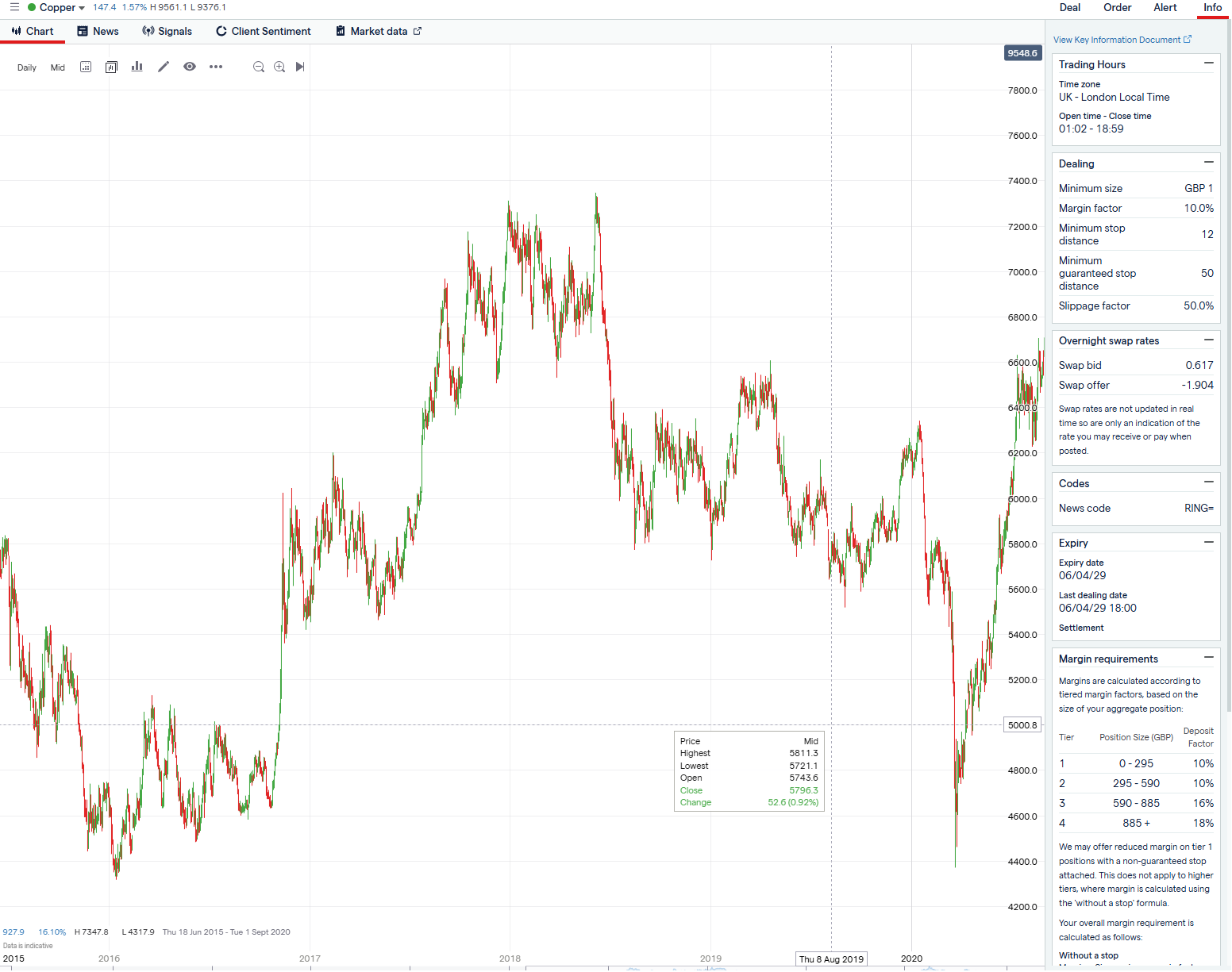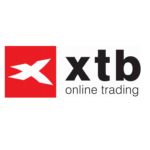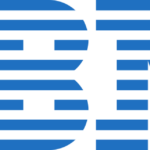You can buy copper as an investment in the UK through ETFs, companies related to the copper mining industry or derivatives through a commodities broker. In this guide, we’ll explain how buy copper in each of these ways.
Is Copper a Good Investment?
The industrial non-metalic metal, often dubbed ‘Dr Copper’ for its predictive power on the global economy, has been on a roll this year. Belonging to Group 11 in the periodic table, the element (ticker ‘Cu’) is a malleable component with many industrial applications. So good is copper’s electrical conductivity that it is a major input to electric vehicles. Each of these battery-powered EV requires 132 pounds of copper.
Another point mentioned here is that other industrial metals like Nickel and Aluminium have also rebounded sharply this year. The latter is forming such a perfectly rounded base that a breakout seems imminent.
The core message from the runaway copper prices is that the economy may be doing better than expected. Shortages of copper (due to deteriorating ore quality from existing mines) may be exacerbating this problem. Of course, the bears will highlight that, after a strong rally, it could be dangerous to get involve in the copper sector. The risk reward ratio is simply too poor. Whilst this may be true, some exposure – albeit with tight risk discipline – may still be desirable.
Susannah Streeter, head of money and markets, Hargreaves Lansdown recently said of copper’s performance as an investment that “The threat of more potential tariffs from Trump is moving markets as investors assess the knock-on effect on goods across the global economy. Not only has the President re-committed to introducing 25% tariffs on imports from Canda and Mexico but he’s been scouting for other targets. Copper prices have shot up, as the metal is caught in the President’s sights. Mining stocks have helped drive the FTSE 100 higher in early trade after copper futures jumped around 4%, sparked by the President ordering an investigation into extra duties on imports.”
Buying Copper Exchange Traded Funds
The first place to look at (leveraged futures contracts and spread bets aside) are ETFs that invest in the metal directly. One such industrial commodity ETF that focuses on industrial metals is the Invesco DB Metals (DBB). The fund, which holds copper, zinc and aluminium in its portfolio (factsheet), allows the shareholders to spread the risk slightly amongst the three metals.
It’s not available on most traditional share trading platforms, but you can buy Investor DM Metals with an IG share dealing account (pictured below):

You can also invest in are ETFs that hold these miners. For instance, the $2.6 billion Global X Copper Miner ETF (COPX, factsheet) has a portfolio of copper miners. One advantage of using this fund is that it spreads the sector risk with 40 holdings. Two, these holdings can be from many non-US stock exchanges. Investors thus have a global copper mining exposure with this fund alone.
Buying Copper Related Companies
The second area to place bets on the bullish copper metal are miners. These companies mine the ground to extract the metal. Their profit margin derives from difference between the cost of production and sales of copper ore/metal.
In the UK, the most concentrated copper bet is Antogafasta Plc (LSE:ANTO). With mines in the copper-rich region of Chile and Peru, Antofagasta’s copper production this year is estimated to be around 670-710,000 tonnes. Its share price have been rallying hard over the past few months on strengthening copper prices (see below).
Another interesting copper stock with high positive momentum is Southern Copper (US:SCCO) listed in the US. Freeport McMoRan (FCX), a large copper producer, just broke new all-time highs.
Trading
Trading Copper Derivatives
Instead of owning copper or copper-related companies you can speculate on the price of copper moving up or down through financial spread bets or CFD trading. With these products, you are trading on leverage, which means your profits and losses are also amplified. See for example trading Copper on IG below as a spread bet (where profits are tax free).

Copper is a fairly easy derivative to trade as market liquidity remains ample. The stunning rally in US equities and crypto over the past year suggested that the high borrowing costs are not denting investor enthusiasm for risk. Yes, there are some bearish trends like China. But we also are also seeing new stock market highs in India, Japan, UK, some European indices, and most importantly, the US. These rallies generate new liquidity and widen risk appetite. Many funds are piling into commodities.
If we cast our eyes further, the wider commodity market is roaring ahead, too. Earlier this year, we saw Cocoa’s spectacular uptrend into the five-digit level. Precious metals (gold in particular) also jumped to new long-term highs. With these growth in raw material prices, inflation may rebound later this year. The scope for interest rate cuts could be narrowing faster than anticipated.
Or, if you are a particularly big trader and need direct exchange access you can trade futures, which also enable you to take physical delivery of copper once the contract settles. You can compare the best trading platforms for trading copper below.
| Commodity Broker | Commodities Available | CFDs | Spreads | Futures | Options | MT4/5 | Customer Rating | More Info |
|---|---|---|---|---|---|---|---|---|
 | 20 | ✔️ | ✔️ | ❌ | ✔️ | ✔️ | (Based on 124 reviews)
| See Platform 71% of retail investor accounts lose money |
 | 20 | ✔️ | ✔️ | ❌ | ❌ | ✔️ | (Based on 16 reviews)
| See Platform 76% of retail investor accounts lose money |
 | 28 | ✔️ | ✔️ | ❌ | ❌ | ✔️ | (Based on 86 reviews)
| See Platform 75.3% of retail investor accounts lose money |
 | 22 | ✔️ | ❌ | ❌ | ❌ | ❌ | (Based on 144 reviews)
| See Platform 80% of retail investor accounts lose money |
 | 20 | ✔️ | ❌ | ✔️ | ✔️ | ❌ | (Based on 934 reviews)
| See Platform 60% of retail investor accounts lose money |
 | 20 | ✔️ | ✔️ | ❌ | ❌ | ❌ | (Based on 257 reviews)
| See Platform 64% of retail investor accounts lose money |
 | 35 | ✔️ | ✔️ | ✔️ | ✔️ | ✔️ | (Based on 678 reviews)
| See Platform 71% of retail investor accounts lose money |
 | 100 | ✔️ | ✔️ | ❌ | ❌ | ✔️ | (Based on 148 reviews)
| See Platform 70% of retail investor accounts lose money |
 | 25 | ✔️ | ❌ | ✔️ | ✔️ | ✔️ | (Based on 73 reviews)
| See Platform 65% of retail investor accounts lose money |
 | 43 | ✔️ | ❌ | ❌ | ❌ | ❌ | (Based on 277 reviews)
| See Platform 61% of retail investor accounts lose money |
 | 22 | ✔️ | ✔️ | ❌ | ❌ | ❌ | (Based on 136 reviews)
| See Platform75% of retail investor accounts lose money |

Richard is the founder of the Good Money Guide (formerly Good Broker Guide), one of the original investment comparison sites established in 2015. With a career spanning two decades as a broker, he brings extensive expertise and knowledge to the financial landscape.
Having worked as a broker at Investors Intelligence and a multi-asset derivatives broker at MF Global (Man Financial), Richard has acquired substantial experience in the industry. His career began as a private client stockbroker at Walker Crips and Phillip Securities (now King and Shaxson), following internships on the NYMEX oil trading floor in New York and London IPE in 2001 and 2000.
Richard’s contributions and expertise have been recognized by respected publications such as The Sunday Times, BusinessInsider, Yahoo Finance, BusinessNews.org.uk, Master Investor, Wealth Briefing, iNews, and The FT, among many others.
Under Richard’s leadership, the Good Money Guide has evolved into a valuable destination for comprehensive information and expert guidance, specialising in trading, investment, and currency exchange. His commitment to delivering high-quality insights has solidified the Good Money Guide’s standing as a well-respected resource for both customers and industry colleagues.
You can contact Richard at richard@goodmoneyguide.com



